Issue 15, September 7, 2016
White Grubs
We have reports of white grub infestations throughout the state. Most of these appear to be Japanese beetle grubs as their numbers have rebounded from being severely reduced by the droughts of 2012 and 2013, and the severe winter that followed. Thanks to Harold Enger of Spring-Green, and others that provided information.
Grub damage shows up primarily on turf that was irrigated and attractive to egg-laying adults in July, particularly the first half of July. Damage appears as irregular brownish spots of turf that are initially only 3 to 8 inches across. As time passes, these brownish areas can enlarge to encompass large areas of turf.

White grub initial injury symptoms
It is common for the grub damage in lawns to stop abruptly at a property line where the adjoining owner may have watered less in midsummer, the lawn has less thatch or better soil; or other factors may account for this.
Similarly, grub injury commonly abruptly drops off at the edge of irrigation or other practices on golf courses. As a result, the rough is likely to have no grub damage or less than the fairway due to the reduced irrigation in July and higher mowing of the rough. White grub damage gradually decreases as one goes under tree canopies. Adult beetles avoid laying eggs under trees.
Grub-damaged turf easily pulls up because the grubs have eaten off much of the root system. In irrigated turf, the grubs are obvious in the root zone when the turf is pulled back. Most will be in the top one-half inch of soil or clinging to the underside of the turf.
If the soil is dry, the grubs typically migrate downward to find moisture. Tilling the upper 2 to 3 inches of soil beneath the turf with a knife or other tool reveals the grubs. Japanese beetle and masked chafer grubs are C-shaped, white, and range in size at this time of year from 1/2 to 1 inch long. They have three pairs of legs and a brown head.
Actively feeding grubs are blackish at the posterior portion of the abdomen. Because white grubs consume soil in their root feeding, this soil is visible through the body wall of grubs that have been actively feeding. White abdomens on grubs indicate that the grubs are not feeding heavily and are probably dying from insecticide or disease.
As a general rule, 10 to 12 grubs per foot square, that is, an area 12 inches by 12 inches, are enough to cause obvious turf damage. Slightly fewer, 8 to 10, cause injury to heavily used turf; and it takes more, 12 to 14, to injure turf that has no traffic. There are numerous reports of turf looking healthy with numbers as high as 30 per foot square, but year after year, 10 to 12 per foot square has shown to be a good threshold for treatment.
The white grubs descend deeper into the soil as it cools with approaching fall weather. In general, they descend out of the turf root zone in early to mid-October in northern Illinois. In central Illinois, that typically occurs in late October, with the grubs moving down in mid- to late November in southern Illinois.
Japanese beetle grubs migrate downward when the turf root zone temperature drops below 60 degrees F. Masked chafer larvae, annual white grubs, migrate deeper into the soil when the root zone temperature drops below 50 degrees F. It is common for the 3-inch soil temperature to be reported on weather broadcasts and in newspapers. This can be used to determine whether the grubs have migrated downward. The best method is to cut through the turf, pull it back, and locate the grubs.
Marginally high grub numbers can be tolerated by well-watered turf. Under the cooler temperatures of fall, turf with adequate rainfall or irrigation grows roots faster than 10 to 16 grubs per square foot typically eat them, resulting in green, healthy turf. In these cases, insecticidal treatment can be avoided.
Although these same grubs migrate back up into the root zone the next spring to feed on turf roots, some will have died over the winter, and the cool temperatures and typically heavy spring rainfall will keep the turf roots growing faster than the grubs can eat them. In addition, the grubs do not migrate up into the root zone in spring until the soil warms to 50 degrees F. However, the turf resumes growth at considerably cooler soil temperatures, allowing the grass to get a head start on the grubs in the spring. In the spring, masked chafer and Japanese beetle grubs only feed into June before pupating, so there is a short duration of spring feeding.
At this time of year, trichlorfon (Dylox), chlorantroniliprole (Acelepryn), or Bacillus thruingiensis galleriae (grubHALT) is recommended for white grub control. Irrigating dry turf a couple of days before treatment to bring the grubs up into the root zone increases control. Water in the application with at least 1/2 inch of irrigation.
Insecticidal nematodes are also effective against white grubs, particularly Heterorhabditis bacteriaphora. Watering a couple of days before applying insecticidal nematodes to bring the white grubs into the root zone also helps increase control. (Phil Nixon)
Author:
Phil Nixon